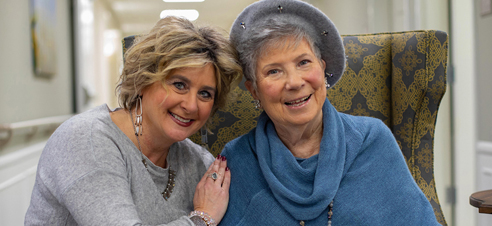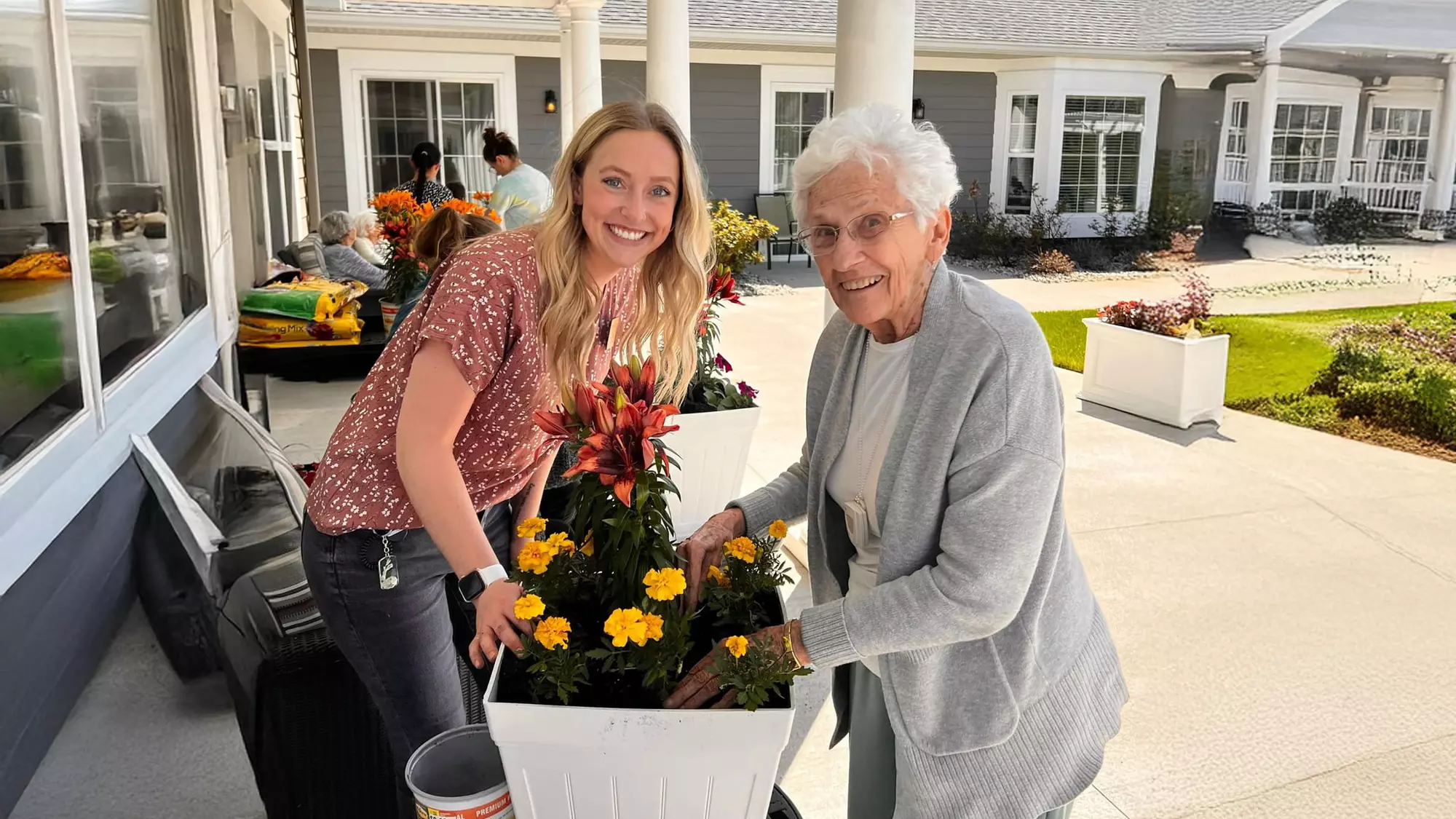As we age, it’s natural for our needs to change. If you or a loved one could use additional support, there’s a wide range of excellent senior living options available.
Both independent living and assisted living are designed to support older adults through different stages of the aging journey, and it’s important to choose the support service that best fits your or your family member’s unique needs. Having a clear understanding of each option can help you choose the right fit for your specific situation.
In this blog, we’ll explain the difference between independent living and assisted living — to help you make a confident and informed choice.
What Is Independent Living?
Independent living is primarily designed for self-sufficient individuals looking to enjoy a relaxed lifestyle in a comfortable setting with like-minded peers. Many independent living communities offer a variety of accommodations and floor plans, convenient amenities, enriching activities and programs, plenty of opportunities to socialize, and more — to help make life more enjoyable for residents.
In addition, chores like yard work and housekeeping are typically handled by employees, so residents can spend more time doing the things they love.
So, who is independent living best for? This option is typically suited for individuals who can manage their daily routines independently. Consequently, an independent living community may not be ideal for someone who requires assistance with activities of daily living (ADLs) or extensive medical support.
What Is Assisted Living?
If you or your family member could use more help with your daily routine, then assisted living is likely a great option. Residents in these communities usually have their own private or semi-private apartments with access to convenient amenities, shared areas, and 24/7 caregiver support.
In addition to assistance with activities of daily living (ADLs), like eating, bathing, or getting dressed, many communities offer healthy and delicious culinary options, fun-packed activities and programs, and opportunities to make new friends.
While most assisted living communities generally do not offer the extensive medical care found in nursing homes, they do partner with outside health care providers to provide on-site medical services.

Key Differences Between Independent Living and Assisted Living
How does independent living differ from assisted living? Both independent living and assisted living can offer many great benefits for you or someone you love, but there are some important distinctions to be aware of.
Here are some key differences between independent living and assisted living:
Level of Support
While many independent living communities offer additional services, like housekeeping, meal preparation, and yard work, residents typically manage their daily routines independently.
In assisted living communities, employees are usually available around the clock to help residents with their daily routines, including assistance with activities of daily living (ADLs), like getting dressed, transferring, or using the bathroom.
Medical Services
Independent living residents don’t require additional support services, so these communities usually don’t provide on-site medical services.
In contrast, most assisted living communities typically assist with medication management or provide access to compassionate support. Some assisted living communities partner with outside health care providers to offer medical services on-site.
Living Arrangements
In independent living, you’ll find a wide range of accommodation options, including family-style apartments, condos, townhouses, or cottages with convenient access to features like swimming pools, fitness centers, and more.
Residents in assisted living typically live in private or semi-private apartments within a larger community. Many assisted living apartments are designed with residents’ safety in mind and provide 24/7 caregiver support and access to shared amenities.
Cost
Because individuals in independent living typically have fewer support needs, it’s generally more affordable.
Assisted living costs often include medical support which can increase the overall cost.
Employee-to-Resident Ratio
Most residents in independent living communities manage daily tasks on their own, so these communities typically have fewer employees on site.
Conversely, assisted living communities tend to have more caregivers available around the clock to ensure support is always nearby when needed.
Activities and Programming
Most independent living communities offer activities and programs that residents can participate in, and residents can choose to pursue their hobbies and interests as they wish.
In assisted living, these activities tend to be more structured and tailored to the residents’ abilities and preferences.

Independent Living vs. Assisted Living Cost Comparison
When deciding between independent living and assisted living, cost is usually one of the most significant factors for many families. Understanding what you might pay and what’s included can help you better plan for your or your loved one’s support.
So, how much does independent living cost? You can expect to pay between $1,500 and $6,000 per month. However, the amount can vary significantly depending on the community’s location, amenities and services, and accommodation options.
Many independent living communities usually charge month-to-month, similar to renting an apartment. However, it’s essential to keep in mind that some communities may charge a one-time community fee when you first move in. Personalized culinary options or additional services may be offered à la carte or in tiered packages.
Independent living usually includes:
- Rent for your private apartment or home
- Basic utilities (like water, electricity, and trash collection)
- Housekeeping and laundry services
- Meals and snacks (often one to three meals per day in a shared dining area)
- Maintenance and landscaping
- Scheduled transportation
- Access to amenities like fitness centers, libraries, walking paths, and community events
The national average for assisted living is around $4,500 per month, with a typical range between $3,500 and $7,000, depending on your location and level of support needed.
You might be wondering: Why is assisted living more expensive? That’s because residents in assisted living communities tend to need more assistance throughout their day, including help with activities of daily living (ADLs). The more assistance you need, the higher your monthly cost may be. Some assisted living communities may charge extra for pets, meals, or upgraded amenities.
Assisted living includes everything offered in independent living, plus:
- Help with activities of daily living (ADLs) such as bathing, dressing, grooming, and toileting
- Medication management
- 24/7 caregiver support
- Emergency call systems
- Wellness checks and care coordination
- Special culinary options (if needed)

How Do People Pay for Independent Living?
While independent living offers many great perks for residents to take advantage of, it does come at a significant cost. Here are some key payment options you might consider to help cover independent living expenses:
- Personal Savings and Investments: These options can provide a good source of funds as you transition to independent living.
- Life Insurance: Some life insurance policies allow you to “cash out” on your savings to help you cover some costs.
- Pension: A pension from a former employer can help you pay for independent living costs.
- Home Sale: The proceeds from the sale of your home can be a source of funds for independent living.
- Long-Term Care Insurance: Most independent living communities accept long-term care insurance payments. However, policies vary in terms of coverage amounts and eligibility.
How Do People Pay for Assisted Living?
Paying for assisted living can be a big financial commitment for many families. Fortunately, there are several ways to pay for assisted living costs, including:
- Private Savings: Families can use personal savings or income from investments to cover assisted living costs.
- Long-Term Care Insurance: Some long-term care insurance policies may help cover assisted living costs. However, it’s essential to review your loved one’s policy to understand exactly what’s covered.
- Veteran Benefits: Veterans and their spouses may be eligible for financial assistance through programs like the VA Aid and Attendance Benefit. In some cases, these benefits can help cover assisted living costs.
- Medicaid: In some cases, Medicaid can help pay for assisted living, but eligibility requirements vary by state. While Medicaid may cover some medical expenses, it may not fully cover assisted living costs.
- Family Support: Sometimes, adult children or other family members contribute financially to help cover the cost of assisted living for their parents.
How Much Does Independent Living or Assisted Living Cost in Your Area?
As you explore additional support services for yourself or a family member, cost is likely a key deciding factor. StoryPoint Group’s Cost Calculator tool is here to help you compare the costs of different senior living options in your area, including independent living and assisted living.

Factors That Influence What Living Option You Pick
When it comes to independent living vs. assisted living, there’s no one-size-fits-all answer. The aging experience tends to look a little different for everyone, so what works for one person might not be the right fit for someone else.
Here are some key factors to keep in mind as you explore your options:
Individual Needs
Independent living and assisted living offer varying levels of support, depending on what’s required. Independent living is often an excellent fit for individuals who can manage their daily routine without much assistance.
If you or a family member could benefit from additional support, including assistance with activities of daily living (ADLs), an assisted living community might be worth considering.
Health Status and Mobility
It’s also important to consider your current health. Are there any chronic conditions or mobility issues to consider? Since most independent living communities don’t offer on-site medical services, they may not be the best fit for individuals with ongoing health needs.
However, if you or someone you love needs help with medication management, transferring, or managing conditions like diabetes or arthritis, assisted living may be a better choice.
Lifestyle Preferences
While both independent living and assisted living offer plenty of services and amenities for residents to enjoy, independent living tends to focus more on enhancing quality of life and enjoyment.
In contrast, assisted living offerings are often more structured to accommodate residents with varying physical abilities.
Financial Considerations
It’s also important to consider your available resources when deciding between independent living and assisted living. Independent living is often less expensive but may offer fewer support services than assisted living.
But, costs can vary significantly between communities. When touring potential options, be sure to ask for a detailed cost breakdown to see what fits your budget.
Future Needs
It’s normal for our needs to change as we grow older, so it’s a good idea to plan ahead. Some senior living communities offer a continuum of care, from independent living and assisted living to memory care, all within the same community.
This allows residents to transition between different levels of support as their needs change, without having to move to an entirely new place.
Family Members’ Input
Close family members can play an important role when choosing between independent living and assisted living. They may provide emotional support, help with tours and finances, or even raise concerns you hadn’t considered.
Common Scenarios for Choosing Independent Living or Assisted Living
It’s not always easy to know when it’s time for a change, but certain signs can help guide your decision between independent living and assisted living.
Below is a simple guide to help you decide whether independent living or assisted living might be the right fit based on your or your loved one’s situation.
Senior Living With StoryPoint Group Communities
At StoryPoint Group communities, our residents’ needs are at the heart of everything we do. Our goal is to help each person make the most of each day, in a way that’s most meaningful to them.
Whether you’re looking for a relaxed lifestyle with convenient access to amenities and plenty of social opportunities, need additional support with activities of daily living (ADLs), or simply want a place to call home, we’d love to be part of your journey.
To learn more about life with us or just to say hello, feel free to contact us or give us a call at 1-844-275-9990.












